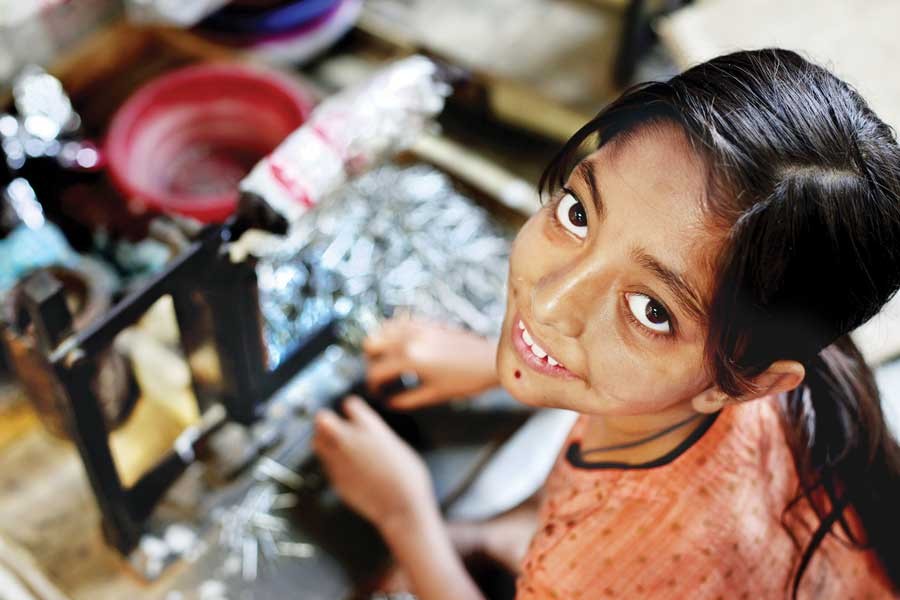
Child domestic workers: Brutalities know no bounds
Sajibur Rahman | Sunday, 24 November 2019

 Torture, repression, torment, sexual abuse, rape and other forms of violence against domestic child workers have become commonplace in the country. What is disturbing is that these incidents have grown alarmingly in urban areas. But in most cases, such brutal acts go unreported and the perpetrators go unpunished, due in part to the absence of legal instruments and monitoring by authorities.
Torture, repression, torment, sexual abuse, rape and other forms of violence against domestic child workers have become commonplace in the country. What is disturbing is that these incidents have grown alarmingly in urban areas. But in most cases, such brutal acts go unreported and the perpetrators go unpunished, due in part to the absence of legal instruments and monitoring by authorities.
Child domestic work is generally understood to be children's work at the home of a third party or an employer regardless of whether it is permissible or not.
Child labour in domestic work refers to the situation in which household chores are performed by children below the minimum age for light work or full-time non-hazardous work. But they often work in hazardous or slavery-like conditions as well.
In addition to the harsh treatment by their employers, child domestic workers get a pittance as wages.
There are no special laws for the protection of child domestic workers. So, in case of violence against minor domestic helps the courts rely on the Children Act 2013 and other common laws of the country. Even more, the existing children law does not recognise child domestic work as labour.
The government approved the draft of Domestic Workers' Protection and Welfare Policy 2015, but it is in name only.
Thus, a large number of innocent, poverty-stricken and orphan children have to live at the mercy of affluent and middle-class families.
In some cases, the offenders have been arrested, but they are getting bail after a certain period. Needless to say, it is the collective failure of the society that it has done little or nothing to protect the child domestic helpers.
The media has reported some of incidents of brutalities by the employers, where child domestic helps were victimised.
For example, on October 18, 2018, a report was published in a national English newspaper uncovering the horror tale of an 11-year-old Lamia Akhtar, who was employed in Barisal.
The picture with a bruised face and injury marks all over her body horrified and shocked the nation.
Six months into the job, Lamia had to suffer frequent physical and mental torture by the couple. She is now undergoing treatment at the child surgery unit at Sher-E-Bangla Medical College Hospital. Even she could hardly be recognised because of her bruised face. Police found the marks of torture all over her body after they recovered her. The child separated from her mother always dreamt of escaping the house as the couple Ashraful and Sharmin allegedly beat her frequently. Police are yet to arrest Ashraful, though a case was filed in this connection.
On October 24, 2018, a report was published on an online news portal that the side-actress Shahana Akter Shaheeni tortured her adopted daughter Prianka in Feni. Local people alleged the she used Prianka as the domestic help and beat her on a regular basis. Prianka is now being treated at Feni General Hospital. Doctors said they found burn injuries in different parts of her body.
Another brutality on a child domestic help was published on October 23, 2018 on another news site. The injured Sima was admitted to the Comilla Medical College and Hospital after she was tortured in Dhaka. Her rickshaw puller father Nurul Islam brought Sima to her employer Nazmul Islam Apu in the capital.
These are the latest examples of brutalities unleashed on the child household helpers.
Like Lamia, Prianka and Sima, many other children are being tortured across the country, but they never make headlines.
There is paucity of data on the child domestic helpers. The National Child Labour Survey by the Bangladesh Bureau of Statistics has no data of the child domestic workers.
But the 2006 baseline survey of the International Labour Organization (ILO) found two million domestic workers in the country, of which 12.7 per cent is children. The number of child domestic workers in the country is 421,426, of which 147,943 work in Dhaka city alone and the remaining 273,543 serve in other urban and rural households alike. Of the total workers, 78 per cent are female and 94 per cent work full-time.
The number of minor domestic helpers, whose 'employment' usually borders on indentured servitude, has certainly multiplied by now because the survey was done over a decade ago.
Rights group Ain o Salish Kendra (ASK), reported over 2,700 incidents involving violence against domestic workers between 2008 and 2011 and it reported 729 deaths child workers during the same period.
A desk review on Child Labour in Domestic Work in Bangladesh by Bangladesh Shishu Adhikar Forum(BASF) in December 2013 revealed that the severity of torture ranged from inhuman working hours with no rest to constant beatings (such as hitting the head against the wall, branding lit cigarettes and hot metal objects against skin, etc).
Against this backdrop, the civil society has long been advocating the recognition of domestic worker as labour and a legal framework for their protection.
Finally, the cabinet approved the draft Domestic Workers Protection and Welfare Policy in December 2015. This is a significant milestone in promoting the rights of domestic workers in Bangladesh.
The policy consists of 16 provisions. These provisions include the rights and duties of domestic workers, their employers, and the government.
So far, the formulation of the policy has been considered a positive step towards the protection of domestic workers, especially child household helps. But the implementation of the policy requires concrete actions and initiatives.
............................................................
Sajibur Rahman is a reporter at The FE.
sajibur@gmail.com